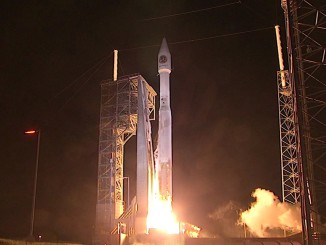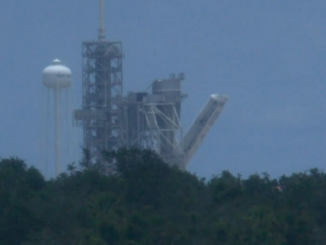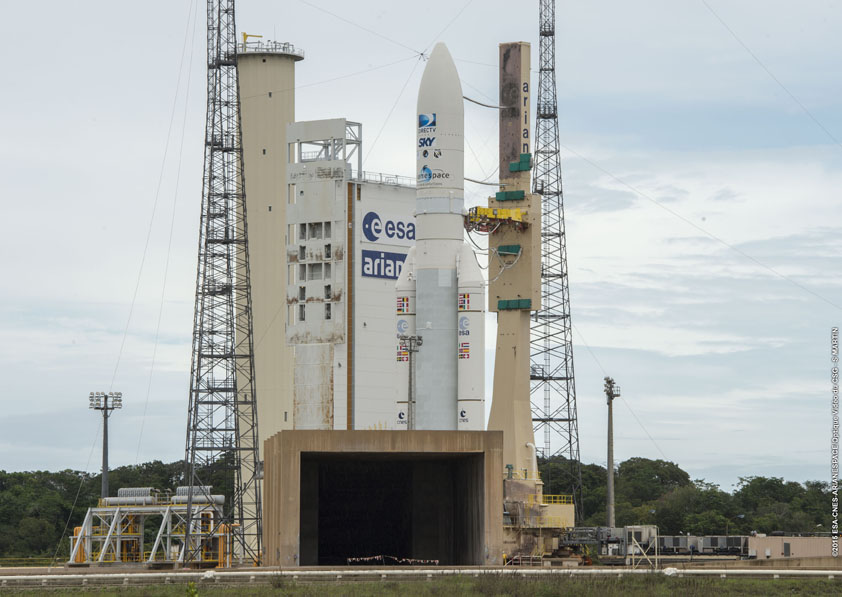
Two satellites equipped to broadcast television programming to millions of homes across the United States and Latin America are braced for launch from French Guiana on Wednesday aboard an Ariane 5 rocket.
Loaded with the DirecTV 15 and Sky Mexico 1 satellites, the 179-foot-tall Ariane 5 rocket rolled out to the ELA-3 launch pad Tuesday at the European-run Guiana Space Center, arriving at the coastal launch facility around midday for final preflight preparations.
Ground crews planned to configure the rocket for the final launch countdown by connecting the Ariane 5 to propellant and electrical systems.
Final preparations will begin early Wednesday, when the all-day countdown kicks off with activation of the Ariane 5’s computers, testing of the rocket’s electrical systems, and filling of the launcher’s two stages with super-cold liquid hydrogen and liquid oxygen propellants.
The launch team will hand over control of the countdown to a computer-run sequence seven minutes prior to launch.
The Ariane 5’s Vulcain 2 main engine will fire at 2116 GMT (5:16 p.m. EDT; 6:16 p.m. local time). Seven seconds later, the launcher’s twin solid rocket boosters will ignite with a burst of fiery exhaust to send the Ariane 5 into the sky.
The strap-on rocket motors will jettison about two minutes later, and the Vulcain 2 core engine will burn for approximately nine minutes before yielding to a hydrogen-fueled HM7B upper stage engine to propel the mission’s payloads to a speed of more than 9.3 kilometers per second, or nearly 21,000 mph.
It will take nearly 38 minutes for the rocket to release its two satellite passengers into geostationary transfer orbit, an egg-shaped loop around Earth stretching up to 35,786 kilometers — 22,236 miles — in altitude.
DirecTV 15 will beam ultra-clear television signals directly to millions of homes across the United States. With a launch weight of 6.2 metric tons, the craft will join DirecTV’s satellite fleet serving more than 20 million subscribers across the continental United States, Hawaii, Alaska and Puerto Rico.
DirecTV also has a stake in the Sky Mexico 1 satellite on Wednesday’s launch.
Sky Mexico is majority owned by Televisa, a Mexican media company, but DirecTV holds 41 percent ownership of the satellite broadcaster.
Phil Goswitz, DirecTV’s senior vice president of space, communications and video, said the company assessed the risk of placing two satellites on the same rocket. Insurance rates for the satellites did not change when the two payloads were paired together, bolstering confidence in the decision to launch DirecTV 15 and Sky Mexico 1 at the same time, he said.
“No one is more conservative than an underwriter who has an opportunity to raise rates,” Goswitz said. “That is probably the greatest testament to Ariane’s reliability and the lack of additional risk.”
The Ariane 5 rocket, operated and marketed by Arianespace headquartered near Paris, has logged 64 consecutive successful launches since 2003.
“The Ariane manifest right now is very full,” Goswitz said. “Our satellites are very highly enabling of revenue for DirecTV, so we want to launch them. We don’t want them sitting on the ground, so we really took the first available opportunity to pair up our satellites.”
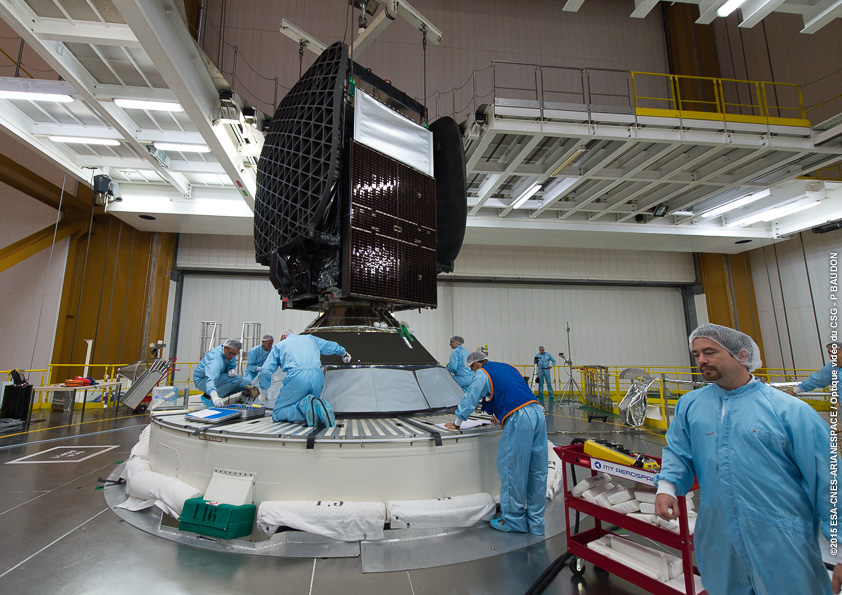
The Ariane 5 rocket typically launches with two large communications satellites at a time. Arianespace officials track the progress of each spacecraft’s construction and assign them to launchers several months before liftoff.
“You try to get your ducks in a row, but the ducks are alive and they keep walking around,” Goswitz said of the pitfalls of dual-payload planning.
For DirecTV, it proved easier to put both its satellites on the same launch, according to Goswitz.
Airbus Defense and Space completed the DirecTV 15 satellite two months ahead of schedule in late 2014. DirecTV 15 is based on the European satellite-builder’s Eurostar E3000 spacecraft platform.
The Sky Mexico 1 spacecraft, made by Orbital ATK in Dulles, Virginia, was finished four months early, Goswitz said.
“Both companies did extraordinary jobs managing the risks and getting the satellites ready,” he said.
DirecTV 15 is the second satellite equipped to broadcast next-generation 4K Ultra HD television signals. The new craft is launching six months after DirecTV 14, which is finishing up testing of the technology required to transmit ultra-sharp TV channels and video programming.
The Airbus-made spacecraft is packed with more than 150 high-power amplifiers, 28 Ku-band transponders and 25 transponders in Ka-band and the so-called “reverse band” normally used to send signals from Earth into space.
Regulators have approved use of the uplink spectrum to transmit revenue-earning programming from a satellite to the ground, opening up the untapped reverse band for commercial exploitation.
“With DirecTV 14 and now DirecTV 15, we’ve significantly expanded our pipe, and it will give us substantial capacity to lead in 4K linear services, especially linear sports, which we think will be spectacular,” Goswitz said in an interview from the French Guiana launch site.
DirecTV subscribers with Ultra HD televisions will see channels from DirecTV 15 with four times as many pixels as a 1080p high-definition signal.
Goswitz said Hollywood movie studios are beginning to film in 4K Ultra HD, and DirecTV customers will initially see the ultra-sharp programming in video-on-demand options. DirecTV expects live sports broadcasts and cable channels to follow the lead of the studios in adopting 4K Ultra HD.
“We’re going through the same kind of dynamic that we had with the rollout of high-definition services,” Goswitz said. “There’s additional investment, and everyone is going to have to step up to that investment. They’re a little reluctant to do so at the start, and that’s part of the process, but they are — starting with the studios — starting to announce the availability of 4K Ultra HD movies, as well as introducing high dynamic range. That’s not only better resolution, but wider color space and higher dynamic range from dark to brightness.”
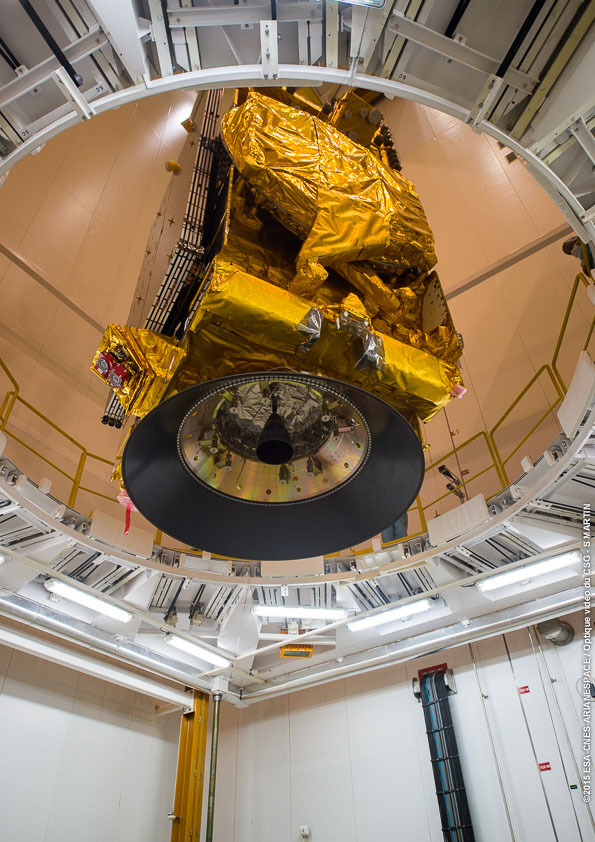
Video-on-demand in 4K Ultra HD is available to customers with an Ultra HD television and existing receivers, according to Goswitz. Subscribers will need an upgraded receiver to access live transmissions when they come online.
After Wednesday’s launch, DirecTV 15 will raise its altitude and circularize its orbit 22,300 miles over the equator, where it will hover at 102.8 degrees west longitude. The spacecraft’s Ku-band instrumentation will offer backup capacity for DirecTV’s existing services in case older satellites need to be replaced.
“It’s essentially — by design — a very flexible satellite, but its primary mission will be national Ultra HD and additional high-definition services for our main coverage area,” Goswitz said.
Sky Mexico 1 will broadcast television channels across Mexico, Central America and the Caribbean from 78.8 degrees west longitude. It is Sky Mexico’s first dedicated satellite, adding to capacity leased from an Intelsat spacecraft stationed over the Atlantic Ocean.
“We are effectively doubling the capability of the business by going from 24 to 48 (transponders),” Goswitz said. “We’re adding 24 additional transponders, which will allow for substantial growth. (Sky Mexico) will be able to significantly change their competitive position and greatly improve their offerings.”
Email the author.
Follow Stephen Clark on Twitter: @StephenClark1.

